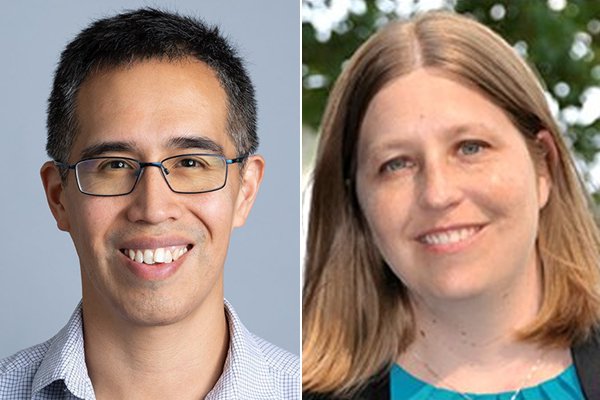Setting the Agenda in Biology Research: Two A&S Faculty Members Join NIH Peer-Review Committees
Associate Professors Carlos Castañeda and Jessica MacDonald have accepted standing memberships with NIH study sections, with terms that began this July.

The Center for Scientific Review (CSR) is known as the “gateway” for National Institutes of Health (NIH) grant applications. Expert peer review groups —also called study sections — formed by the CSR assess more than 75 percent of the thousands of research grant applications sent to the NIH each year. The work done by these sections is designed to ensure each application gets a fair, impartial and thorough evaluation for scientific merit and promise, and that funding is awarded without any inappropriate influence.
Accomplishing that feat every year requires extensive time, dedication and expertise, and in the NIH’s own wording, only those who have “demonstrated competence and achievement in [their] scientific discipline as evidenced by the quality of [their] research accomplishments, publications in scientific journals, and other significant scientific activities, achievements and honors,” are invited to take part.
Two associate professors in the Department of Biology, Carlos A. Castañeda and Jessica MacDonald, joined their ranks beginning this summer, having accepted standing memberships in the Maximizing Investigators’ Research Award B (MRAB) Study Section, and the Developmental Brain Disorders (DBD) Study Section, respectively.
A standing membership represents a significant commitment of professional time and dedicated energy — one that can be tricky to balance with teaching and research workloads. A member typically spends several weeks reviewing 10-12 applications of 60-100 pages each before each meeting, and then prepares a detailed written report and presentation in order to discuss the application with the rest of the committee. Castañeda accepted a six-year appointment, with a commitment to join two of the section’s three meetings each year; MacDonald’s membership is for four years, meeting three times each year.
In return for that commitment, of course, the work promises significant rewards — in the opportunity to contribute to the nation’s biomedical research efforts, while raising the research profile of Syracuse as an institution as well as advancing the professors’ own scientific goals.
“I’ve often found that evaluating and reading grants lets you see what’s happening at the edge of science,” says Castañeda, who joined the Syracuse faculty in 2014, appointed jointly to the departments of biology and chemistry after earning a Ph.D. in biophysics from Johns Hopkins University and doing post-doctoral work at the University of Maryland College Park. “[It’s useful to see] what are new and up-and-coming techniques, and to track where the field is going and what is pushing the next set of scientific questions.”
The section that he is a part of is unique in that it exclusively reviews Maximizing Investigator’s Research Award (MIRA) grants, which fall within the purview of the National Institute of General Medical Sciences (NIGMS) and provide funding for laboratories doing broad-based biomedical research. “A lot of basic science grants are reviewed at that institute,” Castañeda says. “My [section] is focused on biochemistry and biophysics, such as understanding how proteins and other macromolecules work.”
MIRA grants are intended to fund a lab for a period of five years, for both established and new- or early-stage investigators. Introduced in 2016, the MIRA program was created to provide funding stability, greater flexibility and higher acceptance rates than more typical R01 project grants. There has been a shift within NIGMS to this model, with an increasing number of MIRA grants funded each year.
MacDonald’s standing membership in the Developmental Brain Disorders (DBD) Study Section — which reviews grant applications to study the factors that lead to abnormal brain development and function — dovetails with her own work focusing on how disruptions in genetic and epigenetic mechanisms cause neurodevelopmental and cognitive disorders. The applications reviewed investigate a mix of pre-clinical research on brain development and clinical studies involving human patients.
Before joining the Syracuse faculty in 2015, MacDonald was a post-doctoral fellow in stem cell and regenerative biology at Harvard; she earned her Ph.D. in neuroscience from the University of British Columbia.
While the specific grants she reviews fall into her areas of expertise, every member of the section sees and hears the details of each application presented. “It gives me a very different perspective on the research,” she explains. “My lab is a basic research lab focused on understanding mechanisms of brain development and disorders. Participating in this study section allows me to better understand how to translate our research into clinical studies.”
Both professors have been recipients of NIH funding themselves: MacDonald a five-year grant in 2019 from the National Institute of Neurological Disorders and Stroke supporting her ongoing research into Rett Syndrome; Castañeda a five-year grant beginning in 2020 enabling him and his team to investigate the underlying cell mechanisms linked to neurodegenerative diseases such as ALS (Lou Gehrig’s disease). As a pragmatic advantage, they note that participating in the review process helps them to gain a better understanding about what makes a successful grant application— wisdom they can share with their colleagues.
“It’s helpful in the sense that [reading grants] helps you write grants,” Castañeda says. “You can see the best way to tell a story. And as we learn what works and doesn’t work, we can tell other people here at [Syracuse]. Hopefully that will raise everyone’s research profiles.”
Featured
Carlos Castañeda Associate Professor
Jessica MacDonald Associate Professor
Media Contact
Laura Wallis
